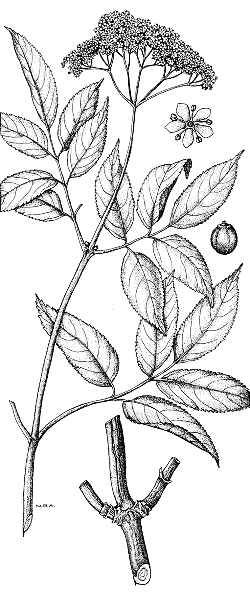Blue Elderberry
Scientific Name: Sambucus nigra ssp. cerulea (L.) R. Bolli
Synonym: Sambucus arizonica, Sambucus caerulea, Sambucus cerulea, Sambucus coerulea, Sambucus glauca, Sambucus mexicana ssp. cerulea , Sambucus neomexicana, Sambucus velutina
Family: Caprifoliaceae
Sunset®: 1-10, 14-24
USDA: 4-10
Frost Tolerance: Hardy to 0°F (-18°C)
Sun Exposure: Full sun to light shade
Origin: Western North America, from British Columbia to northern Mexico
Growth Habits: Deciduous large shrub or small tree, up to 30 feet tall (9 m); grayish brown bark, with abundant raised lenticels; pinnately compound leaves, 6 to 12 inches long (15-30 cm), 5 to 9 (to 11) serrate leaflets, 1 to 6 inches long (2.5-15 cm)
Watering Needs: Regular to little water needed when established, prefers moist, well drained, sunny sites
Propagation: Offset, seeds, cuttings
Three varieties are grenerally recognized:
- var. cerulea (S. cerulea), native in most of the range, 5 to 9 leaflets, less than 3.2 inches long (8 cm), very glaucous fruits, branchlets and leaves mostly glabrous.
- var. neomexicana (S. neomexicana), from New Mexico, Arizona and Colorado, 5 or 7 leaflets, larger ones longer than 3.2 inches (8 cm).
- var. velutina (S. velutina), from the Sierra Nevada in California, western Nevada, and northwestern Arizona, with the branchlets densely pubescent, as well as the leaflet undersides, leaflets less than 3.2 inches long (8 cm).
Blooming Habits:
Small white flowers, in flat top clusters, 1.6 to 6 inches in diameter (4-15 cm), or more, in late spring or early summer.
Fruiting Habits:
The elderberry has small blue to black, glaucous berries, 0.06 to 0.12 inch in diameter (1.5-3 mm). The fruits of the elderberry are very attractive to birds. They are also edible and can be used to make jelly or wine. Tea made with the dried flowers is supposed to be good for the cough.
Propagation:
Cuttings are easy. Seeds need stratification.
Desert-Tropicals is dedicated to provide gardening advice, gardening ideas, and information about flower of all kind for landscape and collections.We try to check carefully the identification of the plants on the illustrations as well as the other information from the page, but occasionally errors do occur. if you notice anything that needs to be changed please contact us.Thanks.
© 1998-2020 Philippe Faucon, All Rights Reserved.
